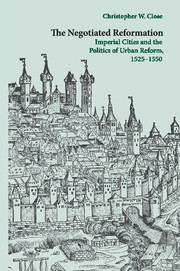Book contents
- Frontmatter
- Contents
- List of Abbreviations
- Acknowledgments
- Map One South German Imperial Cities ca. 1525
- Map Two Imperial Cities in Upper and Eastern Swabia
- Introduction
- 1 Consultation and the Urban Hierarchy
- 2 Imperial Cities and Collective Politics
- 3 Preachers, Consultation, and the Spread of Urban Reform in Southern Germany
- 4 The Urban Reformation in Donauwörth
- 5 The Urban Reformation in Kaufbeuren
- 6 Negotiation and the Rural Reformation in Eastern Swabia
- 7 Eastern Swabia and the Schmalkaldic War
- Conclusion
- Bibliography
- Index
- References
6 - Negotiation and the Rural Reformation in Eastern Swabia
Published online by Cambridge University Press: 26 December 2009
- Frontmatter
- Contents
- List of Abbreviations
- Acknowledgments
- Map One South German Imperial Cities ca. 1525
- Map Two Imperial Cities in Upper and Eastern Swabia
- Introduction
- 1 Consultation and the Urban Hierarchy
- 2 Imperial Cities and Collective Politics
- 3 Preachers, Consultation, and the Spread of Urban Reform in Southern Germany
- 4 The Urban Reformation in Donauwörth
- 5 The Urban Reformation in Kaufbeuren
- 6 Negotiation and the Rural Reformation in Eastern Swabia
- 7 Eastern Swabia and the Schmalkaldic War
- Conclusion
- Bibliography
- Index
- References
Summary
At the same time that Augsburg sought to guide the introduction of religious reform in Donauwörth and Kaufbeuren, its council undertook a concerted effort to spread the Reformation to its surrounding countryside. These attempts at rural reform constituted another facet of the city's program of religio-political expansion. Unlike its Three Cities' allies Nuremberg and Ulm, Augsburg did not control an extensive hinterland. It exerted tremendous economic influence on nearby villages, but its jurisdiction outside the city walls was limited. During the 1530s and 1540s, Augsburg's council employed religious reform as a means of establishing greater authority over neighboring rural communities. One of its most controversial undertakings centered on Mindelaltheim, a village in the Habsburg margravate of Burgau. After consulting with Ulm, in October 1544 Augsburg installed an evangelical preacher named Hans Hess in the village. It acted on authority of the parish's right of presentation, which belonged to the city's Dominican convent, St. Katharina. This act did not go unnoticed for long. King Ferdinand, who controlled high justice in Mindelaltheim, demanded Augsburg “remove the preacher…. If this does not occur, we will act against him ourselves under the authority granted us by our territorial lordship.” To counter Ferdinand, Augsburg sought aid from its Schmalkaldic allies. The League's estates refused to support the city, stating they “could not defend Augsburg's introduction of a preacher in Mindelaltheim, which is in direct violation of the king's princely authority.” Reluctantly, Augsburg's council removed Hess.
- Type
- Chapter
- Information
- The Negotiated ReformationImperial Cities and the Politics of Urban Reform, 1525–1550, pp. 179 - 208Publisher: Cambridge University PressPrint publication year: 2009

